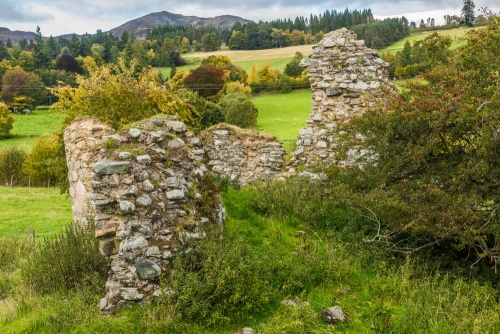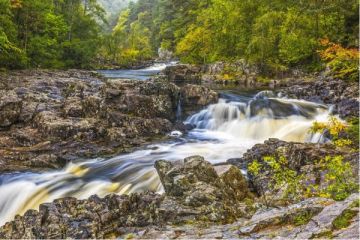
The picturesque hamlet of Moulin is set on the hillside overlooking Pitlochry. In a field below the old kirk of Moulin (now the Pitlochry & Moulin Heritage Centre) stand the crumbling ruins of a 14th-century fortress known as Caisteal Dubh Mhaothlinne (Black Castle of Moulin).
History
The castle was built in 1326 by Sir John Campbell of Lochawe, Earl of Atholl. Robert Bruce gave the lands at Moulin to the Campbells as a reward for fighting at his side at the Battle of Bannockburn in 1314. A dozen years later Sir John erected a castle on his new lands, possibly on the site of an earlier fortification.
Black Castle was built on a marsh or small loch. That might seem an odd choice at first glance but actually, it was inspired. It seems that Sir John first built a crannog, or manmade island in the middle of the loch, and built his castle on the crannog. The only approach to the castle was by a causeway across the loch (drained in 1720).

Black Castle was a departure from the traditional motte and bailey design popularised by the Normans. Instead of a high mound encircled by a timber palisade, Campbell's castle was a roughly rectangular shape and used a high curtain wall with round corner towers, but there was no central keep or fortified tower.
Within the embattled walls were ranges of buildings such as stables, a hall, chapel, and workshops. The rounded castle towers enabled the defenders to fire on attackers from two sides at once.
The walls would have been 30 feet high and were up to 6 feet wide. Only part of one corner tower remains, in the north-west corner.
This 'enciente' design drew heavily on the castles built by Edward I during his late 13th-century campaigns in north Wales.

Deadly Plague
We know that the castle stayed in use until 1500 when an outbreak of the Black Death (Bubonic plague) hit the Highlands. A local tradition says that the castle inhabitants were struck down by the deadly disease when an infected messenger arrived. The castle was burned by the inhabitants to stop the plague from spreading further.
It was the Black Death that led to the castle's popular name 'Black Castle'. We do not know what it may have been called before 1500, but after the Black Death the new name stuck.
Another version of the story says that the inhabitants of Black Castle all died from the plague. Local residents were too afraid to enter the empty fortress to deal with the corpses so it was destroyed by cannon fire, collapsing the walls like a funeral cairn over the bodies of the dead.
The castle mouldered away for centuries until it was overwhelmed by foliage and damaged by livestock. In 2002 a restoration project solidified the castle walls and cleared the worst of the vegetation. The stonework was repointed using a traditional lime mortar and the walls were capped with a layer of clay and turf to keep the rain out.

Getting There
You can see the castle ruins across the fields from East Moulin Road. The easiest way to reach the ruins is by the signposted footpath behind the heritage centre on Kirkmichael Road in the centre of Moulin. There is a small parking area opposite the heritage centre entrance.
Facing the heritage centre, follow the road on your left as its skirts the burial ground. You go past a row of houses and then you will see a gate into the field beyond the houses.
There is an information panel at the gate, explaining the history of the castle. Go through the gate and follow the obvious footpath diagonally across the field towards the castle, which is in sight the whole way.
From the heritage centre to the castle takes only five minutes and the going is easy. There is a fence around the enclosure to keep livestock out but you can go through a gate and explore the ruins.

It is hard to interpret the site as most of the walls have fallen and those that remain standing are in poor condition. You can, however, get a very good look at the masonry construction technique in the exposed sections of walls and foundations.
Note
Historic Environment Scotland calls Black Castle a 13th-century castle. This is at odds with the information on the castle information panel about Sir John Campbell, which we've given here.
About Black Castle (Caisteal Dubh)
Address: Moulin,
Pitlochry,
Perthshire,
Scotland, PH16 5EJ
Attraction Type: Castle
Location: On a footpath from the Moulin Heritage Centre (postcode PH16 5EJ).
Website: Black Castle (Caisteal Dubh)
Location
map
OS: NN947589
Photo Credit: David Ross and Britain Express
NEARBY HISTORIC ATTRACTIONS
Heritage Rated from 1- 5 (low to exceptional) on historic interest
Pitlochry & Moulin Heritage Centre - 0.3 miles (Museum) ![]()
Sunnybrae Cottage - 0.8 miles (Historic Building) ![]()
Pitlochry Dam & Fish Ladder - 1 miles (Historic Building) ![]()
Dunfallandy Stone - 1.6 miles (Prehistoric Site) ![]()
Craigower - 1.6 miles (Countryside) ![]()
Killiecrankie - 3 miles (Countryside) ![]()
Linn of Tummel - 3.1 miles (Countryside) ![]()
Tay Forest Park - 4.9 miles (Countryside) ![]()
Nearest Holiday Cottages to Black Castle (Caisteal Dubh):
More self catering near Black Castle (Caisteal Dubh)



